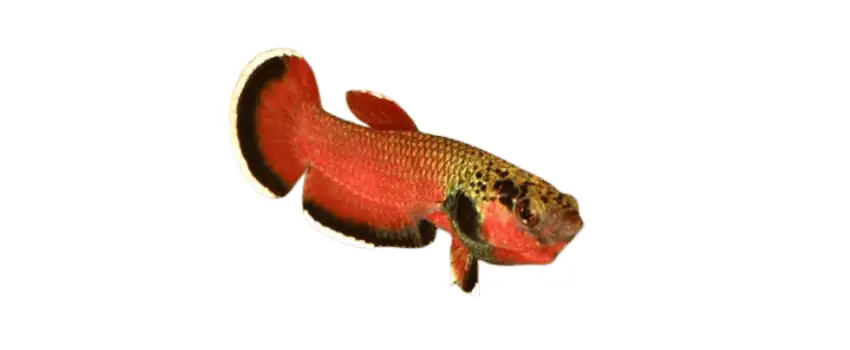Betta channoides, the Snakehead Betta, is a beautiful fish species to keep.
It’s a member of the Betta splendens complex.
This species naturally occurs in Southeast Asian waters, especially near Indonesia and Malaysia. A few common natural locations of Betta channoides include the following:
- Mahakam River Basin
- Mujup
- Sungai Merimun
- Muarapahu
- Pampang
Due to its natural habitat, this tropical fish prefers acidic waters with plenty of tannins.
Learn more about the Betta channoides species, and prepare to care for one yourself.
Table of Contents
Appearance

Betta channoides are attractive tropical fish. They feature orange-colored bodies, and their fins and ventrals are black with white trim.
Like other betta species, Betta channoides are sexually dimorphic.
This means males and females have notable differences in appearance. In channoides, males also have a broader head shape than females.
Male bettas tend to be more colorful than females, and their fins tend to be more prominent.
Many betta keepers suggest Betta channoides are similar in appearance to Betta albimarginatas. The difference is: albimarginatas have an all-black dorsal fin, whereas channoides fish do not.
Unique Differences
Betta channoides are mouth brooders, rather than bubble nesters. This makes it more difficult to breed them than several other varieties.
The male carries fertilized eggs in its mouth until they hatch. But if it becomes stressed or frightened, it may swallow or spit out the eggs too early.
Lifespan
This betta fish can live from two to five years in captivity.
You may be able to extend your betta’s life through proper care, diet, and precaution.
Average Size
Betta channoides are a smaller variety of betta fish, typically reaching up to 2″ inches long. Male bettas tend to grow longer and larger than females do.
Ensuring your young betta gets a balanced, protein-rich diet may help it grow to its full potential.
Betta Channoides Care
Compared to other betta fish varieties, Betta channoides are somewhat easy to care for.
This is partly because they’re less aggressive than many other varieties. With channoides, you don’t have to worry as much about aggression or bullying issues.
Tank Size
Betta channoides are a rare betta species which can live peacefully with other bettas.
It’s recommended to keep channoides together in a pair. This helps with mating, as the pair will have a long time to get used to each other.
For a breeding pair of Betta channoides, opt for a minimum tank size of 10 to 15 gallons.
If you plan on housing two males together, ensure the tank is at least 20 gallons.
Water Parameters
These tropical fish require specific water quality and parameters to thrive.
Since their natural habitats include Indonesian and Malaysian waters, they need acidic tank water. Further, they thrive in warm water temperatures.
Keep the tank water within these parameters:
Ideal Water Parameters for a Betta Fish Tank Include the following:
- Temperature: 78-80° degrees Fahrenheit (25.5-27° C)
- pH: 6.5-7.5
- Ammonia and Nitrite: 0 ppm
- Nitrate: < 40 ppm
- gH: 3-4 dGH (50-66.7 ppm)
- kH: 3-5 dKH (53.6-89.4 ppm)
- Minimum Tank Size: 5 Gallons
Also, keep ammonia and other toxins as close to zero as possible.
What To Put In Their Tank
Betta channoides need their environment to mimic their natural habitat. Include these things in their tank setup to give them a happy, healthy life:
Substrate
Place a gravel or substrate layer on the betta tank’s bottom. Ensure it’s of a neutral color, as bright colors will cause your fish stress.
Also, consider mixing leaf litter into the substrate. This way, it will better mimic the channoides’ home waters and add tannins.
Plants
Betta channoides prefer tanks with plenty of plants. Here are a few great aquarium plants to consider adding:
- Java moss
- Java fern
- Frogbit
- Anubias
Your channoides will also love having leaf litter and driftwood in their tank. These things add essential tannins to the water.
Filter
Include an aquarium filter to keep the water circulated and clean.
The filter will help remove various toxins from the water, including ammonia.
Opt for a low-flow filter design, which will pose less risk to your bettas’ fins. Very powerful filters may damage their fins upon accidental impact.
Keeping it low-flow also ensures the tank water is never too circulated. Betta channoides prefer calm waters mimicking their natural habitat.
Lighting

Add a lighting element to your betta tank.
It’s best to choose a lighting system with programmable cycles.
This will benefit your betta fish and any aquarium plants in the tank.
For your bettas, it will provide a more natural atmosphere.
They’re more likely to thrive if you give them a more defined “day” and “night.” It will keep their circadian ryhthms regulated, improving their quality of life.
For the plants, regular lighting will help them grow larger and healthier.
Heater
Install a heater in your Snakehead Betta’s tank.
This variety of betta fish requires warm water conditions to thrive.
Having a heater will help take the guesswork and extra effort out of keeping the water within optimal parameters.
Hiding Places
A lack of hiding places will cause your betta fish stress.
Snakehead Bettas’ wild habitat includes a variety of plants which provide ample coverage. Also, there are various places to hide within their native home.
Consider putting some driftwood in the tank.
The driftwood will provide hiding spots for your bettas and add essential tannins to the water.
Tannins are especially important for this betta variety, as they’re a key feature of their natural environment.
Also, consider buying aquarium decorations from your local pet shop. Opt for those with hidey-holes where your bettas can hang out when they’re feeling stressed.
Possible Diseases
Betta channoides are not especially prone to any one disease. But they are at risk for any of the most common diseases in freshwater fish:
- Dropsy
- Swim bladder disease
- Ich
- Popeye
- Tail and fin rot
- Flukes
- Anchor worms
- Betta fish lice
Keep your bettas healthy by keeping the fish tank optimized for their well-being. Also, watch your bettas regularly for common signs of illness:
- Lethargy
- Lack of appetite
- Flashing
- Discoloration
- Damage to fins or tail
Food & Diet

It’s best to feed your bettas a variety of food types, as this diversifies their nutrition and feeding experience:
- Live foods. Betta channoides prefer live foods. Adding these to your bettas’ rotation will ensure they get a protein-rich diet. It will also give them a more natural feeding experience. A couple of favorite foods of this species of betta include bloodworms and baby brine shrimp.
- Frozen foods. This option tends to be cheaper and more convenient than live foods. It still offers plenty of essential nutrients, but without the hassle of handling live creatures.
- Freeze-dried foods. An even easier option is freeze-dried betta food. This consists of live foods bettas love, but it’s been freeze-dried for longevity and convenience.
- Pellets and flakes. These are two types of commercial food, and they offer ample nutrition for betta fish. Bettas tend to prefer pellets over flakes, but they will usually eat either one. Also, betta pellets are especially easy to clean out of the tank after feeding to reduce ammonia buildup.
By giving your bettas the proper food and varying their diet, you will help them thrive daily.
Behavior & Temperament
Betta channoides are a more peaceful species than many other betta varieties.
Many betta keepers will keep a pair of betta (male and female) together to help with breeding.
Betta channoides males can sometimes live together in the same tank. But we recommend being cautious if you choose to house two males together.
If you notice any aggression or bullying issues, house the two bettas separately.
Tank Mates
Unlike other betta varieties, Betta channoides don’t usually live well in community tanks.
This being said, achieving a healthy and safe community tank environment is possible.
If you choose to house your Betta channoides with other species, consider these options:
- Shrimp
- Corydoras
- Kuhli
- Tetra
- Norman’s Lampeye Killi
These species are smaller and more peaceful than others, making them perfect for your Betta channoides.
Breeding

Have you bought a pair of betta for breeding purposes?
Betta channoides are somewhat difficult to breed since they’re mouthbrooders. Here’s what you need to know about the breeding process:
- It’s normal to keep a pair of Betta channoides together in the same tank long-term. However, you must put your bettas into a separate breeding tank before having them mate.
- The male and female bettas will go through a courtship process before mating. This will involve the female undergoing physical changes to show she’s ready to mate. One notable physical change is the development of vertical stripes on her body.
- Once the pair is ready to mate, they will engage in a courtship dance. During this dance, the two fish twirl around each other. The male aims to release sperm over the eggs as the female releases them.
- Now, the male betta will collect the fertilized eggs in his mouth. He’ll keep them there until the fries are ready to hatch. This can take anywhere from 10 to 21 days, on average.
- Once the fry hatch, the male betta will spit them out. At this point, we recommend moving the male and female betta from the separate breeding tank. The fries are free-swimming and will care for themselves.
There are a couple of crucial things to keep in mind before breeding:
Male Betta channoides easily become anxious.
If this happens while it’s carrying eggs in its mouth, it may swallow or spit them out.
To keep the male betta calm, keep the female in the tank with it until the fry hatch.
Also, Betta channoides have smaller brood sizes than other betta varieties. This contributes to the difficulty of breeding this species.
Price
Betta channoides are most often bought in pairs.
One pair of Betta channoides can cost anywhere from $60 to $125, on average.
You may end up paying more for bettas featuring more vivid coloring or more prominent fins.
Rarity
Betta channoides are somewhat rare and difficult to find in shops.
This is due to this betta variety’s breeding difficulties. Males are prone to swallowing or spitting out the fertilized eggs if they spook, and broods are usually small to begin with.
FAQs
Are Betta Channoides Aggressive?
Betta channoides are a relatively peaceful species compared to other bettas. But they still show aggressive and territorial behavior.
This type of betta does well when housed in male-female pairs.
Sometimes, two males can live together peacefully (if the tank is large enough).
What’s the Difference Between Betta Channoides vs. Betta Albimarginata?
These two betta varieties have striking similarities in appearance. However, they do have one distinguishing feature: the dorsal fin.
Betta channoides have dorsal fins red or orange color. On the other hand, Betta albimarginatas have much darker dorsal fins, sometimes even black.
What Size Are Betta Channoides?
Betta channoides are a smaller betta variety. In terms of body size, they usually reach up to two inches in length.
Males tend to grow larger and longer than females do.
Feeding your bettas a proper diet from a young age can help them grow to their full potential.
Give Your Betta Channoides Proper Care
Betta channoides are a beautiful betta variety and somewhat easy to care for.
But even the most experienced betta keepers could use a little help.
This is exactly why we created this site! Use our resources to help your fish live their best and longest lives.


